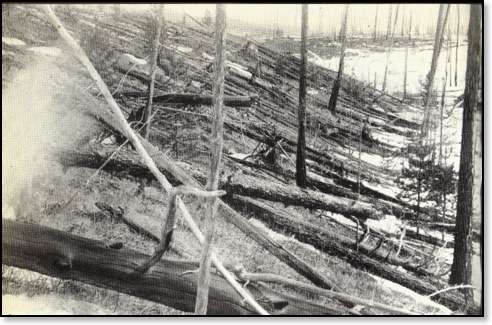JUNE
How softly runs the afternoon
Beneath the billowy clouds of June!
Towne
A forest felled by the Tunguska explosion, June 30, 1908
June 1
1831 Captain Ross reached the North Magnetic Pole, then situated on the desolate peninsula of Boothia Felix, 70° 5' N., 96° 46' W.
June 2
1779 A water-devil whirlwind passed across an Aberdeenshire loch on a fine, calm day, raising a pillar of spray as high as the tallest trees.
June 3
1769 Captain Cook observed the transit of Venus in the South Seas. Simultaneous observations in Europe gave the first accurate measurement of the Sun's distance. See here.
June 4
1944 A Channel storm caused the invasion of Normandy to be postponed. A gust of 51 m.p.h. (82 km/hr.) was recorded at Kew. June 6th became D-day.
June 5
1792 Gloucester and the surrounding country was visited by an intense frost and deep snow.
June 6
1816 In the 'Year without a Summer' snow fell on June 6th in Vermont from dawn to mid-afternoon. Snow was 12 inches (30 cm.) deep in Quebec.
June 7
1931 The strongest earthquake recorded in Britain shook England and Scotland. The epicentre was in the North Sea east of Hull.
June 8
1783 The great Laki fissure eruption in Iceland began. The lava volume was three cubic miles. A famine followed and 1/5th of Iceland's population died. See here.
June 9
1860 A duck-egg sized mass of 'friable sandstone' fell at Raphoe, Ireland.
June 10
1866 The astronomer Tempel observed a star-like light in the lunar crater Aristarchus.
June 11
1800 A tornado like a 'sky blue serpent' emitting 'torrents of fire' caused great damage at Quintana in Spain.
June 12
1748 A hailstorm in London with stones two inches (5 cm.) across.
June 13
1887 Over fifteen hours of sunshine were recorded at Kew Observatory in London.
June 14
1945 One of the lowest temperatures recorded in Australia; -8° F. (-22° C.) at Charlotte Pass.
June 15
1793 A great eruption of Vesuvius began. Lava flowed from a fissure half a mile long.
June 16
1819 An earthquake killed 1,543 persons at Cutch in India. The town of Sindree and adjoining country were inundated by a tremendous rush from the ocean.
June 17
1882 A tornado formed 90 miles (145 km.) west of Grinnell, Iowa, and moved E.N.E. at 57 m.p.h. (92 km/hr.) Grinnell was struck at 8.30 pm, with 100 killed and 150 injured.
June 18
1178 The waxing crescent Moon was seen to split in two from Canterbury, and a flaming torch emerged. Possibly a giant lunar meteorite impact.
June 19
1835 The Great New Brunswick Tornado caused great forest and property damage in New Jersey on a track 17 miles (27 km.) long before becoming a waterspout in New York Bay.
June 20
AD 540 The Anglo-Saxon Chronicle recorded an eclipse of the Sun in which stars were visible. The eclipse was total in the Mediterranean.
June 21
1855 There was a white frost in southern England, and thick ice formed on ponds and still water. The grass minimum at Greenwich was 26° F. (-3° C.)
June 22
1928 Will Keller, of Greensburg, Kansas, saw the interior of a tornado. The walls were of rotating clouds and the hollow centre was illuminated by lightning.
June 23
1809 A rainstorm with a heavy fall of toads the size of hazelnuts at Poitiers in France.
June 24
1225 The Winchester Annals recorded a very great snow with thunder and lightning. The 'snow' may have been graupel or soft hail.
June 25
1890 An 188 lbs. (85 kg.) stone meteorite was seen to fall at Farmington, Kansas, after a detonating fireball.
June 26
1807 The magazine of a fortress in Luxembourg was struck by lightning and exploded, wrecking the lower town. 230 lives were lost.
June 27
1906 The strongest recorded Welsh earthquake occurred at 9.45 am. It was centred near Swansea and was felt over an area of 37,800 square miles. (60,000 square kilometres)
June 28
1812 A 'waterquake' in Marseilles harbour caused much shipping damage. The water sank, rushed out and returned with great force several times.
June 29
1904 A tornado caused great damage and many casualties in Moscow. A child was carried several kilometres.
June 30
1908 A fiery body passed across the sky and exploded with 12-megaton force near the Tunguska River, Siberia. Millions of trees were blown down. See here.
